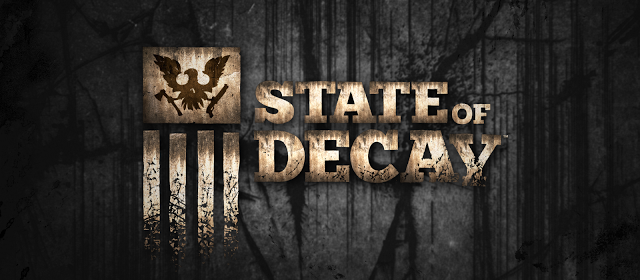There are generally two types of apocalyptic infection story: the serious, mature horrors such as Dawn of the Dead, ZombiU and The Last of Us; and the not-so-serious like Dead Rising, Zombieland and Left 4 Dead, where zombies walk a fine wire between genuine threats and animated playthings. State of Decay falls into the latter category, combining black humour with a mild threat level to produce a game that entertains rather than thrills you.
State of Decay begins with main character Marcus Campbell returning from a two week hunting trip with his best friend Ed to find the world overrun by flesh-eating zombies. What follows is an exercise in survival, resource gathering, and man-management as Marcus and a handful of other survivors attempt to get by in the Hell the world has become.
The suburban setting could have been lifted from any of a score of zombie-themed games and movies, populated by a decent mix of stereotypes and clichés who all have something to bring to the party. The other survivors are what give State of Decay its colour, and the cocktail of personalities and character traits make a great group dynamic, even if there are way too many to keep a real track of.
Your primary motivation in State of Decay is staying alive, but there are lots of factors involved. After the shaky tutorial sees Marcus and Ed meet soldier Maya Torres and make their way down to rendezvous with a group holed up in the church of the nearby town, you get to take over, becoming responsible for the day-to-day running of the beleaguered community. You’ll need to manage supplies, including food, fuel, ammo, construction materials, and medicine. A shortage of any one supply will result in a loss of morale amongst your survivors, and low morale can lead to arguments, ruptures and, eventually, departures.
On occasion you’ll be tempted to let them run riot while you pop off for a spot of recreational zombie smashing, but it’s not an ideal solution. Your life will be much easier should you take the time to not only appease your survivors, but also get to know them. If you make friends with another character you can body-jump into them, allowing Marcus to rest and recuperate. Tired or wounded characters will have reduced health and stamina, and the last thing you want is to be surrounded by a zombie horde with a busted leg.
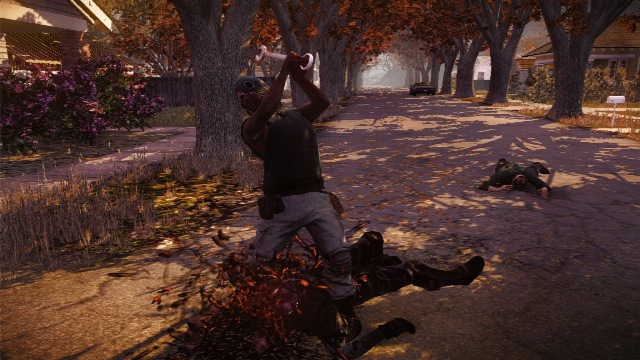
Each character comes with a unique set of personality traits, and five skill areas that will increase depending on your actions. Cardio will increase as you run, for instance, while Wits will improve as you search houses and buildings for supplies. It’s a good system that makes it easy to train characters up just by taking different people out on supply runs. Strangely, while some missions will see you partnered up with one or more other survivors (for example, missions that see you go out to hunt down special zombies), you can’t opt to take someone with you on scavenging trips. In a world where going out alone is tantamount to suicide, and given the fact that two backs are better than one for carrying extra goodies, it seems remarkably stupid to not allow you to go out in groups – especially when certain missions allow for it.
You can radio back to base when you find a bundle of supplies (or break it open for smaller items such as weapons or pain pills) to fetch another survivor out to pick it up and then escort them back, but it means a lot of waiting around – and there’s always a risk that the runner could die while outside the safehouse. Usually that wouldn’t be a problem, but death in State of Decay is permanent, and you could lose a well-trained character and whatever gear they’re carrying. Worse still, some characters have vital skills such as cooking or medical training, and losing them could have a real negative impact on your morale.
There are plenty of ways to find supplies on the map, but the most effective is to climb a radio mast or water tower and get the lay of the land. While surveying the surroundings you can mark houses and other buildings, vehicles, patrolling hordes, special zombies, supply caches, and trapped survivors. Fairly realistic placement of useful items is handy: diners have food, homes have medicine in the bathroom cabinet or building materials and fuel in the garage, etc. It ensures that your supply runs make sense, and it’s much more tense and involving than simply finding glowing pick-ups lying around. You’ll also have to be careful: zombies don’t see very well but they have great hearing, and so everything you do has a noise level. You can hold LB to speed up your searching, but it will make a lot of noise that will attract the dead. Likewise, different guns have different decibel levels and running around or driving cars will draw unwanted attention your way.
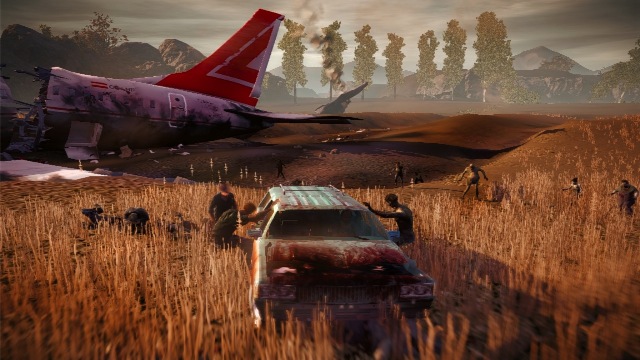
Home defence and upkeep is the secondary motivation, and to this end you can establish watchtowers, barricade windows and, with the right materials and people, build whole new areas such as gardens to grow food, a munitions shop to create your own ammo and a workshop to repair cars (vehicles never run out of fuel, but if they’re destroyed, they never respawn). Further to this, different rooms have different properties and uses, such as the kitchen, which allows you to cook big meals (if you have enough food and a character who can cook) that temporarily boost everyone’s stats. Watchtowers can be upgraded into sniper towers, and a library area will let you research new buildings.
While the story is never really more than a sequence of standard zombie apocalypse events (rescuing stranded characters, dealing with power struggles, assisting or dodging the totalitarian military regime attempting to keep order), it does enough to hold your interest, which is lucky, as the side-missions will become tedious very quickly. You’ll be constantly assailed by people asking for help, either to find a missing loved one, hunt down a new type of zombie, destroy a nearby infestation, or retrieve their belongings. At first these side missions are fun to complete, but by advancing the story you’ll unlock a lot of special infected types that make moving around the world (especially at night) a bit troublesome.
The freak zombies are nothing particularly original: among others, the Screamer stuns you momentarily, the Big ‘Un charges you and is incredibly hard to kill, and the feral zed is analogous to Left 4 Dead’s stalking hunter, flinging itself all over the place. The further you advance the story, the more zeds turn up and the harder it is to get out and get back alive. Hordes in particular are a pain: if they spot you, you’ll have around ten zeds on you all at once – and they increase in frequency steadily as you complete story missions. It helps to move to bigger safehouses now and then, and establish lots of outposts – safe zones where you can hide for the night or access the community supply cache. A fast-travel system would have been handy at times, but that would have ruined the immersion and tension of having to hoof it everywhere while surrounded by the clamouring dead.
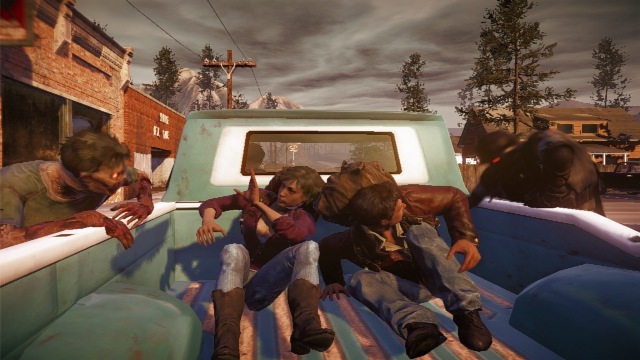
The day / night cycle is fairly oppressive. In the daytime, scavenging is easier – in fact, everything is easier – but at night, when you’re navigating by a flashlight that will attract distant zombies, going out is a pain. Unfortunately, if you don’t you’re going to get bored easily as there’s no way to advance time. Characters only rest when you switch out of them. Even upon returning to the game after a period away, you’ll see that your resources have depleted and your morale has shifted accordingly.
Keeping your community happy, well, fed and rested is essential – and you will want to keep them alive because it’s very easy to become attached to the characters. Taking a pissed-off resident for a stroll to take their frustrations out on the zeds is a nice touch, and improves your overall standing to boot. It’s important to keep everyone as sharp as possible for supply runs – and because the game has a habit of sending random survivors out on “missions” without your say-so.
The biggest problem with State of Decay is that, while the community management grants its own sense of empowerment and the constant runs to top up supplies and bring new people into your fold are all well and good, so much of the game feels unfinished. It’s a technical shambles, plagued by awful texture popping, weird visual glitches, zombies that pop out of existence or get stuck halfway through walls, and some very strange AI patterns. Couple this with some odd design choices and State of Decay almost feels like an open beta, rather than a full game to fork out 1600MS for.
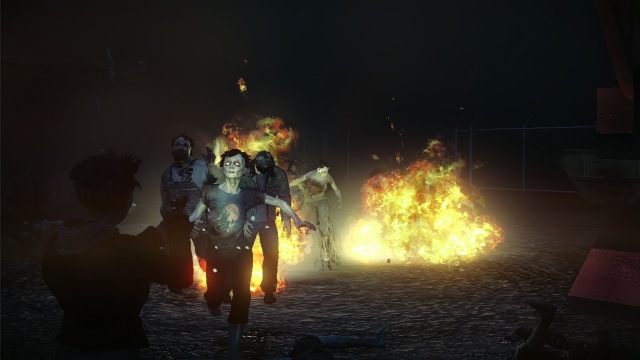
The combat is enjoyable enough, but it’s hard to hit anything with any gun other than a shotgun and melee scrapping can feel imprecise and a little floaty. The running away, however, scrambling up fences and leaping through windows, is always exciting, even if you’re charging through the game world too fast for the texture mapping to keep up. The audio design is pretty decent, too, ramping up the tension when you’re picking through an empty house in the dark and you hear the tell-tale groan coming from downstairs, signalling that a wandering zed has come to investigate your clumsy rummaging. The writing is practically industry standard for darkly-comic zombie horrors, and the characters – while incredibly generic – are at least entertaining. One liners here and there will raise a smile, and there are multiple references to other works in the genre.
It can be a tad tedious having to keep running back to your base to quiet squabbling residents by taking them out on jaunts, or being bombarded by radio requests every five minutes, but there are many who will find State of Decay utterly compelling and addictive simply because it’s so involved.
Finding yourself stranded in the sticks (and you could; the map is impressively huge) while searching for vital medicine with no ammo and a melee weapon that’s about to break as the sun goes down is one of the most tense and exciting feelings you’ll experience in a zombie game, it’s just a shame that it’s not often circumstances will lead you down that path unless you’re incredibly reckless – at least for the first 10 hours or so. As more and more freakish zombies emerge and resources dwindle (nothing respawns), it will become harder to control your community and harder to recuperate from exhaustion and injury.
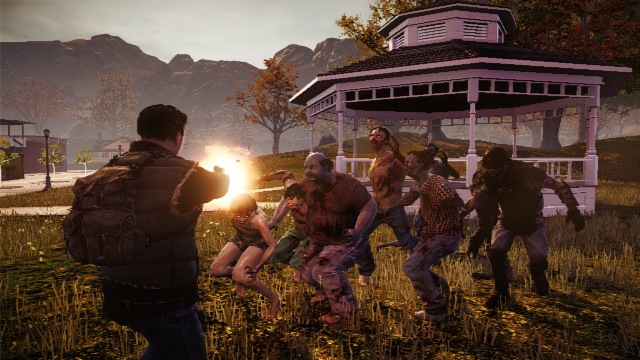
State of Decay is a solid survival sim with enough new ideas to justify the purchase for any discerning zombie fan but, ultimately, there are a few areas that could have been better. The clichéd zombie invasion storyline is actually put to good use here, adding a feeling of familiarity to proceedings that’s almost comforting, but a little originality would have been preferable to such deliberate and obvious homage. No other game comes so close to letting you live out your zombie apocalypse fantasies, and the huge supply of weapons and items (molotovs, grenades, weapon mods and tools) means something as mundane as ransacking an abandoned house at least gives you that kleptomaniacal thrill that comes with looting everything in sight in the hopes of finding something really cool.
VERDICT: Aside from some truly awful graphical issues and a few mechanics that seems conspicuous by their absence, Undead Labs’ open world zombie-fest is actually a good game. How much you enjoy State of Decay will be reliant on your love of the genre and your willingness to overlook the multitude of bugs and glitches that could potentially mar the experience. In an increasingly crowded genre, State of Decay does enough things differently to guarantee its appeal, marrying the sometimes silly atmosphere of Zombieland with the group dynamic of The Walking Dead to deliver a highly enjoyable – albeit imperfect – vision of the end of days.

GOOD. A game that scores 7/10 is worthy of note, but unworthy of fanfare. It does many things well, but only a few of them incredibly well and, despite a handful of good qualities, fresh ideas and solid mechanics, it fails to overwhelm.


